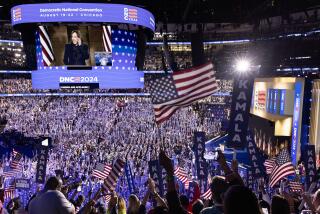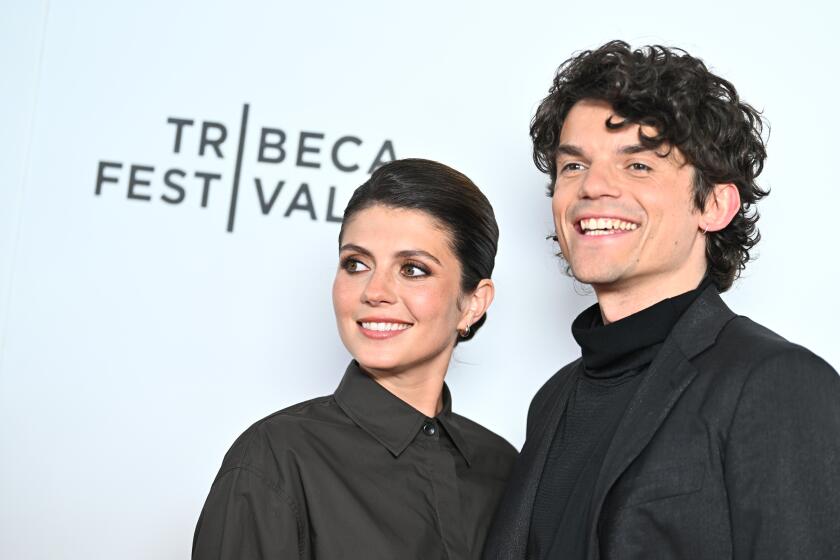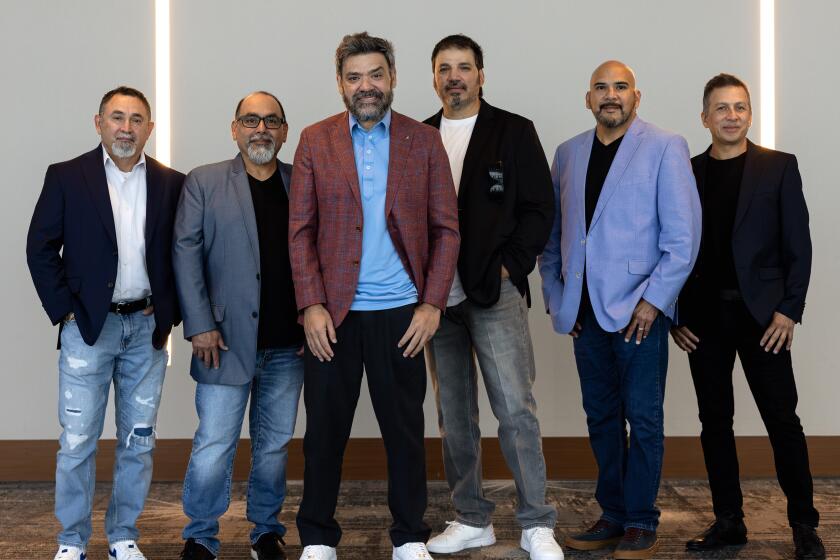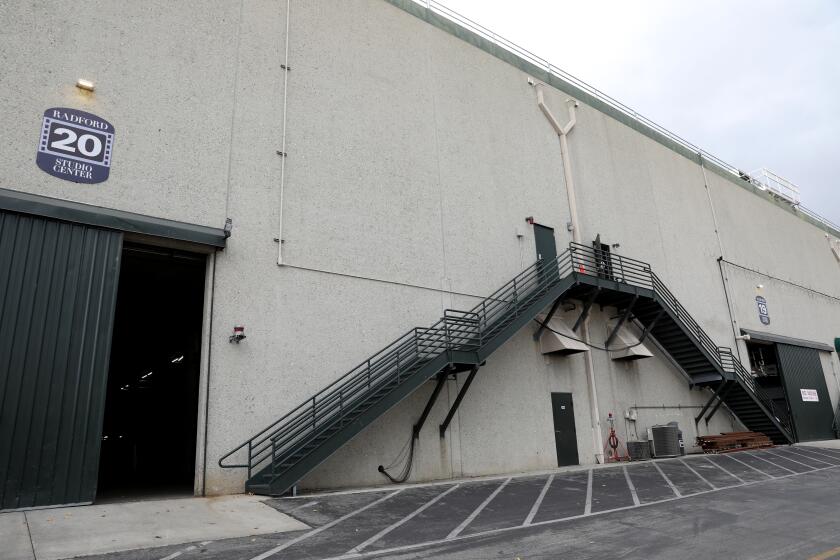CalArts gets its close-up
BEFORE he dreamed up “SpongeBob SquarePants,” his character who would tickle the fancy of the nation’s toddlers, Stephen Hillenburg was ruminating about Einstein’s Theory of Relativity.
Hillenburg did that with animated figures also -- he imagined a fly on the steering wheel of a car whizzing down a surreal highway, the insect pondering a leap onto the driver’s wristwatch, a play on Einstein’s attempts to illustrate for average minds his pioneering understanding of how great speed would alter time and perception.
It’s a safe bet that film and TV viewers of today would never guess that the seven-minute film on the bug-eyed fly in the speeding car, with actual physics formulas shooting across the screen, emerged from the same mind that produced the walking, talking “sponge unlike any other” who lives undersea in a pineapple and whose antics have gained an audience of 50 million since “SpongeBob’s” debut on the Nickelodeon network in 1999.
That was six years after Hillenburg came up with his short film inspired by Einstein’s theory -- called “Wormholes,” though it has no worms -- as his master’s thesis at the California Institute of the Arts. Hillenburg had entered the school as a marine biology teacher seeking a new career, one who “never really imagined running a TV show, certainly not a phenomenon like ‘SpongeBob.’ ” He also could not have imagined that his 1993 student film would wind up being shown at the Museum of Modern Art here, something that will happen Thursday on the opening night of a MoMA film series spotlighting the early works of graduates of CalArts, the Valencia, Calif., school founded 45 years ago by Walt Disney.
Running through midAugust, the film series “Tomorrowland: CalArts in Moving Pictures” was organized by Joshua Siegel, the museum’s assistant curator of film and media. He says he “read the resumes of filmmakers I respected and found they had something in common,” namely links to the college for creative types north of Los Angeles.
Siegel became intrigued by the possibility of showing the student work of some of the figures who helped mold the visual popular culture of our times, whether it was Hillenburg or the founders of Pixar, the animation storytelling factory that had its own show at MoMA last year. Pixar visionary John Lasseter was the second student accepted into CalArts’ animation program and began toying, while there, with bringing a desk lamp to life, an image that eventually was to become the symbol of the company behind “Toy Story,” “Monsters, Inc.” “The Incredibles” and other hits.
*
Pixar prominence
NOT surprisingly, entire nights of the MoMA series will be devoted to the “School of Pixar,” with showings of the student films of Lasseter, Pete Docter and more than a dozen of their colleagues. Other programs are devoted to the early film experiments of future studio artists who studied at CalArts under John Baldessari, such as painter David Salle and Tony Oursler, who videotaped an ongoing “psychosexual soap opera” he staged with puppets in the CalArts cafeteria. CalArts alumni who went on to produce special effects for the “Star Wars” and “Spider-Man” movies also have their student films in the MoMA screenings, as do a couple of students destined for very different careers -- actors Ed Harris and Paul Reubens (then Paul Rubenfeld).
Part of the intrigue in those cases is seeing whether it’s possible to draw a line from A to B, whether the student work foreshadowed the well-known films or other art each went on to produce. While Hillenburg’s “SpongeBob” future may have been hard to predict, “Lasseter and the Pixar animators’ talent at storytelling was quite evident,” Siegel says.
But for others, their student films remain, to date, their claims to fame.
Brooke Keesling can boast of having both of her CalArts projects on the MoMA schedule. They are an oeuvre with a consistent worldview, each contrasting her girlhood fantasies with truths she learned later on. Her first student film was the two-minute “Meatclown,” about her “love/hate relationship” with the mascot of the nation’s most prominent hamburger chain. Produced by positioning puppets and shooting them one frame at a time, it uses a bouncy song to re-create Keesling’s belief as a girl that hamburgers grew on trees, only to have the reality graphically present itself when Ronald McDonald’s head spins around and turns into a meat grinder.
“I was traumatized by the truth of McDonald’s,” quips the ebullient dark comedienne, “but I still like cheeseburgers.”
*
Life lessons
KEESLING’S 2001 thesis film, “Boobie Girl,” contrasts a little girl’s desire for an ample bosom with her discovery that there’s a downside to getting what you wish for, like not being able to balance on roller skates, and having other girls whisper, “I think she swallowed Dolly Parton.” Only at the end credits of that animated short do viewers get a strong hint that it’s not a fictional fable, when Keesling thanks her doctor for “the most splendid breast reduction.”
“Boobie Girl” virtually took over Keesling’s life for two years, winning a Student Academy Award and showing at 70 film festivals, earning her trips to Tokyo, Cannes, Sundance and the like, financed in part by her sales of $20 “Boobie Girl” T-shirts.
“It’s like having just the teeny-weeniest perfect piece of fame,” says Keesling, who worked for a special-effects company after graduation but says her goal always was to teach. The two student films -- and the recommendation of a CalArts teacher -- helped her achieve that just recently when she was hired to “help raise the bar,” as she puts it, at the animation department of Detroit’s century-old College for Creative Studies, best known for its industrial and car design programs.
“I don’t expect to become a millionaire,” said Keesling, 37, who while she teaches is making yet another personal film, this one about her father, who once designed “trippy” light shows for rock bands such as Pink Floyd and the Who, and now has a model train store in Hollywood.
Keesling plans to come to New York for MoMA’s opening reception, though her films will be screened later on, as will the film of one of her former colleagues in CalArts’ experimental animation program whom she got into the show. After copies of her films were requested, she threw into the package one made by Dave Lebow, a.k.a. “Maniaman.” By his own admission, Lebow does not expect CalArts to include him yet on its lists of prominent alumni along with Harris, Tim Burton and the Pixar folks.
“I’m probably not famous enough, or famous at all,” says Lebow, who went to CalArts “as an older guy,” after years of painting, to learn animation. He then spent two years making 4,000 drawings by hand for his seven-minute thesis film, “Night Sweats,” about a man who can’t sleep and imagines himself being attacked by an anthropomorphic coffeepot until morning brings a return to his mundane real life.
Lebow, now 51, works part time at CalArts while doing freelance animation, currently for “The Secret Life of ... “ series on the Food Network.
“Every week it’s a different food -- this week I’m working on ‘The Secret Life of Chilled Treats,’ ” he said, detailing how he had to create 11 seconds of animation on the history of sorbet, how “in the Islamic world, merchants would import snow from the mountains [and] mix ice and water and fruit syrup.”
Lebow also produced 10 original paintings for the TV show “Medium” and displays other works, mostly portraits and still-life scenes, on his website, Maniaman.com. He sees some irony in having his student film on insomnia as his debut at one of the world’s leading museums.
“I would love to get a painting in the Museum of Modern Art,” said the artist-animator, “but this is a great way to sneak in.”
More to Read
The biggest entertainment stories
Get our big stories about Hollywood, film, television, music, arts, culture and more right in your inbox as soon as they publish.
You may occasionally receive promotional content from the Los Angeles Times.






